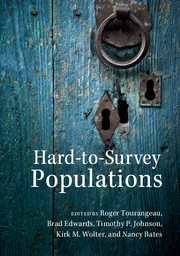Book contents
- Frontmatter
- Dedication
- Contents
- List of figures
- List of tables
- List of boxes
- List of contributors
- Preface
- Part I Introduction
- 1 Defining hard-to-survey populations
- 2 Hard-to-survey populations in comparative perspective
- 3 Measuring undercounts for hard-to-survey groups
- 4 Counting and estimating hard-to-survey populations in the 2011 Census
- 5 A review of quality issues associated with studying hard-to-survey populations
- Part II Conducting surveys in difficult settings
- Part III Conducting surveys with special populations
- Part IV Sampling strategies for the hard to survey
- Part V Data collection strategies for the hard to survey
- Index
- References
3 - Measuring undercounts for hard-to-survey groups
Published online by Cambridge University Press: 05 September 2014
- Frontmatter
- Dedication
- Contents
- List of figures
- List of tables
- List of boxes
- List of contributors
- Preface
- Part I Introduction
- 1 Defining hard-to-survey populations
- 2 Hard-to-survey populations in comparative perspective
- 3 Measuring undercounts for hard-to-survey groups
- 4 Counting and estimating hard-to-survey populations in the 2011 Census
- 5 A review of quality issues associated with studying hard-to-survey populations
- Part II Conducting surveys in difficult settings
- Part III Conducting surveys with special populations
- Part IV Sampling strategies for the hard to survey
- Part V Data collection strategies for the hard to survey
- Index
- References
Summary
Introduction
Measuring census undercount is an important way of gaining insight about subpopulations that are hard to survey. Although such groups may be a relatively small proportion of the population, they contribute disproportionately to the overall undercount. Several methods are available for measuring census undercounts, so countries are able to choose the one that best suits their situation. The methods for estimating net undercount include post-enumeration surveys, demographic analysis, administrative record matches, and reverse record checks. Countries use these methods to make population estimates that are thought to be more accurate than the census; this estimate is then compared to the census count to give an estimate of the net undercount.
The methods have different data requirements, so not every country has the data needed to apply each one. Even when such data exist, some countries have privacy and confidentiality restrictions on how the data are used. Therefore, not all methods can be applied in all countries. Demographic analysis uses vital records in aggregate calculations. Administrative record matches and reverse record checks require high-quality records systems and laws that permit their use to measure undercounts. A post-enumeration survey is a second enumeration implemented on a sample basis after a census and then matched to the census on a case-by-case basis. One advantage of a post-enumeration survey is that is does not depend on the availability of an administrative or vital records system. Even if such records are available, their quality and the characteristics of individuals that they contain are not issues when a post-enumeration survey is done. Therefore, the method may be applied in developed or developing countries.
Information
- Type
- Chapter
- Information
- Hard-to-Survey Populations , pp. 37 - 57Publisher: Cambridge University PressPrint publication year: 2014
References
Accessibility standard: Unknown
Why this information is here
This section outlines the accessibility features of this content - including support for screen readers, full keyboard navigation and high-contrast display options. This may not be relevant for you.Accessibility Information
- 6
- Cited by
